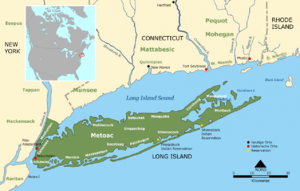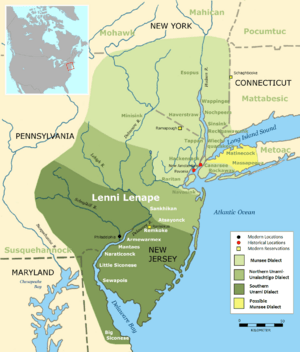Metoac facts for kids
The word Metoac is a term that some people used to describe Native American groups living on what is now Long Island in New York. This term was actually incorrect. It was created by a person named Silas Wood, who was an amateur historian and a U.S. Congressman. He thought that each Native American settlement on Long Island was a completely separate tribe.
However, the Native American peoples on Long Island actually came from two main language and cultural groups. These groups were part of the larger Algonquian peoples who lived along the Atlantic coast. The groups on the western part of Long Island were related to the Lenape people. Those on the eastern part were more connected to tribes in New England, like the Pequots. Silas Wood and early European settlers often mixed up the names of places with the names of different tribes.
Many of the names that the Lenape and Pequot people gave to their villages are still used today by English settlers. For example, the Shinnecock Indian Nation lives in a part of Southampton, New York. They are now officially recognized by the government as a tribe and have their own reservation there.
Contents
What Does "Metoac" Mean?
The term "Metoac" might have come from an Algonquian word, metau-hok. This word means "rough periwinkle." A periwinkle is a small sea snail. The shells of these snails were used to make wampum. Wampum was a type of bead that was very important for trading and as money for Native Americans before and after Europeans arrived.
Languages of Long Island's Native Americans
At the time Europeans first arrived, about 10,000 Native Americans lived on Long Island. They belonged to two main groups and spoke two different languages. Both languages were part of the larger Eastern Algonquian languages family. This shows their connections to people on the mainland.
Native Americans in the west and central parts of Long Island were closely linked to groups in nearby states like Connecticut, Pennsylvania, New Jersey, and Delaware. These people spoke a type of the Lenape language. The Native Americans who lived on the east end of Long Island were more connected to the Pequot people in eastern Connecticut. They spoke a type of the Mohegan-Pequot language.
These Native American groups were not ruled by one central leader. Instead, different bands or communities acted independently. Each group had its own territory in different areas.
European Settlers Arrive
European settlement in this area began in the 1620s. Dutch colonists mostly settled around the Hudson River and western Long Island. The Dutch tried to control the western part of Long Island, including what are now the New York City areas of Brooklyn and Queens.
The eastern part of Long Island was settled by English colonists from the New England Confederation. English settlers from southern New England started moving to Long Island's north shore in the early 1700s. The number of Native Americans quickly went down after Europeans arrived. This was mainly because of new diseases like measles and smallpox. Native Americans had never been exposed to these illnesses before, so they had no protection against them.
The Dutch and English formally divided Long Island in 1650 with the Treaty of Hartford (1650). This treaty set a border running south from Oyster Bay (hamlet), New York. Native Americans on Long Island were very important in the trade economy. They made beads from shells, called wampum, which were used for decoration and as a valuable form of exchange.
Changes and Displacement
Two major wars happened between Native Americans and colonists: the Pequot War (1634–1638) in New England and Kieft's War (1643–1645) near New York City. These conflicts, along with new diseases, greatly reduced the Native American population on Long Island. Some Native American communities also moved away because of pressure from European settlers. By 1659, their population was less than 500 people.
After the American Revolutionary War, by 1788, only 162 Native Americans remained on Long Island. Around this time, a leader named Samson Occom convinced many survivors to join the Brothertown Indians. They moved to western New York, where the Oneida people of the Iroquois shared their land for several years.
Place Names and Groups
For many years, colonists mistakenly used place names as if they were the names of different tribes. In the 1800s, some books incorrectly listed several "tribes" on Long Island.
Silas Wood, the amateur historian, was one of those who made this mistake. He believed that the different Native American groups on Long Island were separate tribes, and he called them all "Metoac." Today, experts know that these historical peoples were part of two main cultural groups: the Lenape and the Wappinger-Wangunk-Quinnipiac peoples. Both of these groups belong to the Algonquian languages family.
Here are some of the names that were mistakenly called "tribes" and where they were located:
| Name | Location | Modern Place Names | Notes |
|---|---|---|---|
| Canarsie | Modern-day Brooklyn and parts of Queens | Canarsie, Brooklyn | Legend says the Canarsie sold Manhattan to the Dutch for beads and trinkets. |
| Corchaug | Around Riverhead and Southold, New York on eastern Long Island | Cutchogue, New York | The Fort Corchaug Archaeological Site is an important historical place. |
| Manhasset | Shelter Island, New York | Manhasset, New York | |
| Marsapeague | South shore, from the Rockaways east into Suffolk County | Massapequa and Maspeth, Queens | |
| Matinecock | Long Island North Shore from Flushing to Huntington | Matinecock, New York | |
| Mericoke | South shore from the Rockaways into Suffolk County | Merrick, New York | |
| Montaukett | East Hampton, New York | Montauk, New York | Their leader, Wyandanch (sachem), signed over much of Long Island to European settlers. |
| Nissequaq | North Shore from Fresh Pond to Stony Brook, New York | Nissequogue, New York and the Nissequogue River | |
| Rockaway | Around Rockaway and parts of Jamaica and Maspeth | The Rockaways (a place name) comes from this group. | |
| Secatague | Islip on the south shore | ||
| Setauket | North Shore from Stony Brook to Wading River, New York | Setauket, New York | |
| Shinnecock | Southampton | Shinnecock Hills, New York and Shinnecock Inlet | This is a federally recognized tribe with its own reservation. |
| Unkechaug | South shore from Brookhaven, New York to Southampton | Patchogue, New York |
Official Recognition Today
New York State has officially recognized the Shinnecock and the Unkechaug as Native American tribes on Long Island. The Shinnecock are based at the Shinnecock Reservation near Southampton. The Unkechaug have the Poospatuck Reservation at Mastic, New York, which is the smallest Indian reservation in the state.
Since the mid-1900s, the Montaukett, Setalcott, and Matinnecock peoples have also formed their own governments. They are all working to get official recognition from both the state and federal governments.
In 2009, the government of President Barack Obama announced that the Shinnecock Indian Nation had met the requirements to be a federally recognized tribe. The Shinnecock were officially recognized by the United States government in October 2010. This happened after more than 30 years of effort, which included suing the United States Department of the Interior.




